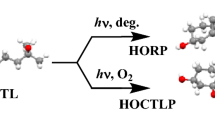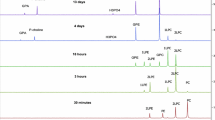Abstract
Hyopochlorous acid generated by neutrophil myeloperoxidase has been shown to convert cholesterol into three different chlorohydrin isomers which previously had not been fully characterized. We have reacted hypochlorous acid with cholesterol/1,2-dipalmitoyl phosphatidylcholine liposomes to give these three major products and established that they are 6β-chloro-5α-cholestane-3β,5-diol (chlorohydrin 1), 5α-chloro-6β-cholestane-3β,6-diol (chlorohydrin 2) and 6α-chloro-5β-cholestane-3β,5-diol (chlorohydrin 3). These products were separated by thin-layer chromatography and fully characterized by 1H, 13C, attached proton test, doublequantum correlation spectroscopy, total correlation spectroscopy, heteronuclear multiple bond correlation and heteronuclear multiple quantum coherence nuclear magnetic resonance spectroscopy.
Similar content being viewed by others
Abbreviations
- APT:
-
attached proton test
- DPPC:
-
1,2-dipalmitoyl phosphatidylcholine
- DQCOSY:
-
doublequantum correlation spectroscopy
- GC-MS:
-
gas chromatography-mass spectrometry
- HMBC:
-
heteronuclear multiple bond correlation spectroscopy
- HMQC:
-
heteronuclear multiple quantum coherence spectroscopy
- NMR:
-
nuclear magnetic resonance
- PBS:
-
phosphate-buffered saline
- TLC:
-
thin-layer chromatography
- TOCSY:
-
total correlation spectroscopy
References
Winterbourn, C.C. (1990) Neutrophil Oxidants: Products and Reactions (Chapter 2), in Oxygen Radicals: Systemic Events and Disease Processes (Das, D.K., and Essman, W.B., eds.) pp. 31–70, Karger, Basel.
Prutz, W.A. (1996) Hypochlorous Acid Interactions with Thiols, Nucleotides, DNA, and Other Biological Substrates, Arch. Biochem. Biophys. 332, 110–120.
Winterbourn, C.C. (1985) Comparative Reactivities of Various Biological Compounds with Myeloperoxidase-Hydrogen Peroxide-Chloride, and Similarity of the Oxidant to Hypochlorite, Biochim. Biophys. Acta, 840, 204–210.
Albrich, J.M., McCarthy, C.A., and Hurst, J.K. (1981) Biological Reactivity of Hypochlorous Acid: Implications for Microbicidal Mechanisms of Leukocyte Myeloperoxidase, Proc. Natl. Acad. Sci. USA 78, 210–214.
Winterbourn, C.C., van den Berg, J.J.M., Roitman, E., and Kuypers, F.A. (1992) Chlorohydrin Formation from Unsaturated Fatty Acids Reacted with Hypochlorous Acid, Arch. Biochem. Biophys. 296, 547–555.
van den Berg, J.J.M., Winterbourn C.C., and Kuypers, F.A. (1993) Hypochlorous Acid-Mediated Oxidation of Cholesterol and Phospholipid: Analysis of Reaction Products by Gas Chromatography-Mass Spectrometry, J. Lipid Res., 34, 2004–2012.
Heinecke, J.W., Li, W., Mueller, D.M., Bohrer, A., and Turk, J. (1994) Cholesterol Chlorohydrin Synthesis by the Myeloperoxidase-Hydrogen Peroxide-Chloride System: Potential Markers for Lipoproteins Oxidatively Damaged by Phagocytes, Biochemistry 33, 10127–10136.
Carr, A.C., van den Berg, J.J.M., and Winterbourn, C.C. (1996) Chlorination of Cholesterol in Cell Membranes by Hypochlorous Acid, Arch. Biochem. Biophys. 332, 63–69.
Hazell, L.J., van den Berg, J.J., and Stocker, R. (1994) Oxidation of Low-Density Lipoprotein by Hypochlorite Causes Aggregation That Is Mediated by Modification of Lysine Residues Rather Than Lipid Oxidation, Biochem. J. 302, 297–304.
Lindgren, B.O. (1967) Reactions of Sterols with Bleaching Agents: Reactions of Cholesterol and Its Acetate with Aqueous Chlorine Solutions, Svensk Papperstidning 70, 532–536.
Lindgren, B.O. (1967) Chlorination of Cholesterol in Aqueous Solution: Isolation of a trans-Diequatorial Chlorohydrin, Acta. Chem. Scand. 21, 1397–1398.
Kettle, A.J., and Winterbourn, C.C. (1994) Assays for the Chlorination Activity of Myeloperoxidase, Methods Enzymol. 233, 502–512.
Hazen, S.L., Hsu, F.F., Duffin, K., and Heinecke, J.W. (1996) Molecular Chlorine Generated by the Myeloperoxidase-Hydrogen Peroxide-Chloride System of Phagocytes Converts Low Density Lipoprotein Cholesterol into a Family of Chlorinated Sterols, J. Biol. Chem. 271, 23080–23088.
Carr, A.C., Winterbourn, C.C., and van den Berg, J.J.M. (1996) Peroxidase-Mediated Bromination of Unsaturated Fatty Acids to Form Bromohydrins, Arch. Biochem. Biophys. 327, 227–233.
Blunt, J.M., and Stothers, J.B. (1977) 13C NMR Spectra of Steroids—A Survey and Commentary, Organic Magnetic Resonance 9, 439–464.
Nittala, S.S., Velde, V.V., Frolow, F., and Lavie, D. (1981) Chlorinated Withanolides from Withania somnifera and Acnistus breviflorus, Phytochemistry 20, 2547–2552.
Ali, A., Sahai, M., and Ray, A.B. (1984) Physalolactone C, a New Withanolide from Physalis peruviana, J. Nat. Prod. 47, 648–651.
Smith, L.L., and Johnson, B.H. (1989) Biological Activities of Oxysterols, Free Rad. Biol. Med., 7, 285–332.
Author information
Authors and Affiliations
About this article
Cite this article
Carr, A.C., Winterbourn, C.C., Blunt, J.W. et al. Nuclear magnetic resonance characterization of 6α-chloro-5β-cholestane-3β,5-diol formed from the reaction of hypochlorous acid with cholesterol. Lipids 32, 363–367 (1997). https://doi.org/10.1007/s11745-997-0046-8
Received:
Revised:
Accepted:
Issue Date:
DOI: https://doi.org/10.1007/s11745-997-0046-8




